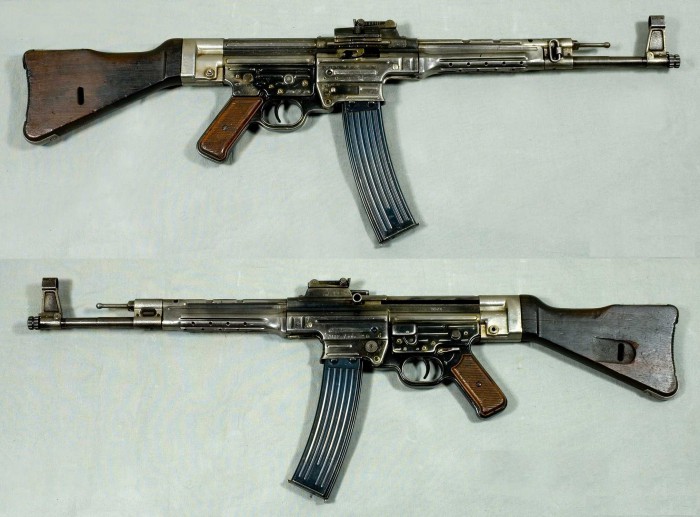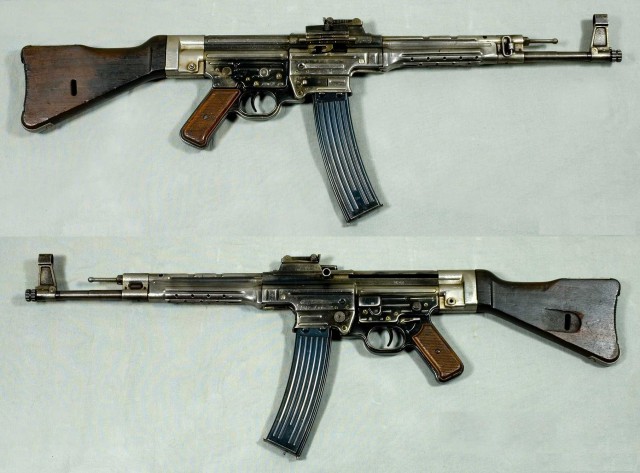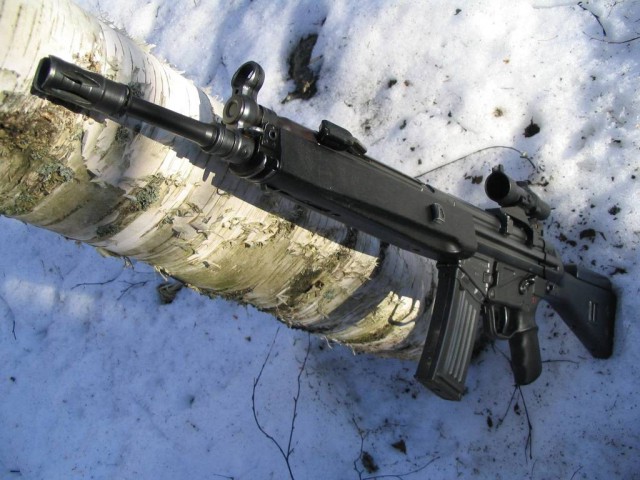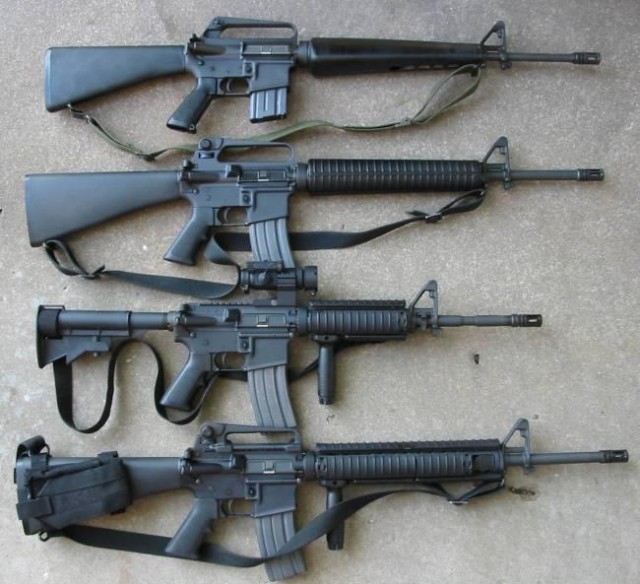
Sturmgewehr Stg 44

In the end, it came too late to have a significant effect on the outcome of the war.
H&K HK33

The HK33 series of rifles were adopted by the Brazilian Air Force, the armed forces of Thailand and Malaysia where they were produced under a license agreement. The rifle was also license-built in France by MAS and in Turkey by MKEK.
H&K G36

The G36 is a 5.56×45mm assault rifle, designed in the early 1990s by Heckler & Koch (H&K) in Germany as a replacement for the heavier 7.62mm G3 battle rifle. It was accepted into service with the Bundeswehr in 1995, replacing the G3. The G36 is gas-operated and feeds from a 30-round detachable box magazine or 100-round C-Mag drum magazine.
The G36 is a selective-fire 5.56mm assault rifle, firing from a closed rotary bolt. The G36 has a conventional layout and a modular component design. Common to all variants of the G36 family are the receiver and buttstock assembly, bolt carrier group with the bolt and the return mechanism and guide rod. The receiver contains the barrel, carry handle with integrated sights, trigger group with pistol grip, handguard and magazine socket.
The G36 employs a free-floating barrel (the barrel does not contact the handguard). The barrel is fastened to the receiver with a special nut, which can be removed with a wrench. The barrel is produced using a cold hammer forging process and features a chrome-lined bore with six right-hand grooves and a 1 in 178 mm (1:7 in) rifling twist rate. The barrel assembly consists of the gas block, a collar with a bayonet lug that is also used to launch rifle grenades and a slotted flash suppressor.
The weapon can be stripped and re-assembled without tools through a system of cross-pins similar to that used on earlier HK designs. For cleaning purposes, the G36 dismantles into the following groups: receiver housing, a return mechanism, bolt carrier group and trigger group.
M16A1

The M16A2 fires the improved 5.56×45mm NATO (M855/SS109) cartridge and has a new adjustable rear sight, case deflector, heavy barrel, improved handguard, pistol grip and buttstock, as well as a semi-auto and three-round burst only fire selector. Adopted in 1998, the M16A4 is the fourth generation of the M16 series. It is equipped with a removable carrying handle and Picatinny rail for mounting optics and other ancillary devices.
FN FNC Carbine

The FNC is a selective fire weapon that uses a gas-driven piston operating system (with a long-stroke piston) and a rotary bolt locking mechanism equipped with two locking lugs that engage corresponding recesses in the barrel extension. The bolt is rotated and unlocked by the interaction of the bolt’s cam pin with a camming guide contained in the bolt carrier.
The spring extractor is located inside the bolt head; the ejector is fixed and riveted to the inside of the receiver housing. The FNC uses a 2-position gas valve, a hammer-type firing mechanism and a trigger with a fire selector switch that is simultaneously the manual safety, securing the weapon from accidental firing. The selector lever is located on the left side of the receiver and has 4 settings: “S” – weapon safe, “1” – single fire mode, “3” – 3-round burst, “A” – continuous (automatic) fire.
The FNC’s barrel features a flash suppressor that is also used to launch rifle grenades. The gas block contains a gas valve setting that is used to isolate the gas system, providing an increased volume of propellant required to fire a rifle grenade.
The sheet-metal gas valve switch when pulled upright, acts as a V-notch sight used for aiming the rifle grenades. The piston head and extension, as well as the gas port block, barrel bore, and chamber are hard-chrome plated to minimize the effects of propellant fouling.
The rifle feeds from 30-round steel magazines that are interchangeable with magazines from the American M16 rifle. After the last round is fired, the bolt will remain closed as there is no provision for an automatic bolt hold open.
Video
“MP44 – Tyskland – 8x33mm Kurz – Armémuseum” by Armémuseum (The Swedish Army Museum) – Armémuseum (The Swedish Army Museum) through the Digital Museum (http://www.digitaltmuseum.se).. Licensed under Public Domain via Commons.
“HK33A2 Flickr (yet another finn)” by yet_another_finn / Mika Järvinen – http://www.flickr.com/photos/74006048@N00/100181594/. Licensed under CC BY 2.0 via Commons.
“800px-G36bw” by Sonaz – first upload in de wikipedia on 12:33, 21. Dez 2005 by Sonaz. Licensed under Public Domain via Commons.
“M16a1m16a2m4m16a45wi” by Offspring 18 87 – Own work. Licensed under CC BY-SA 3.0 via Commons.
“FNC IMG 1527” by Rama – Own work. Licensed under CC BY-SA 2.0 fr via Commons.

Δεν υπάρχουν σχόλια:
Δημοσίευση σχολίου